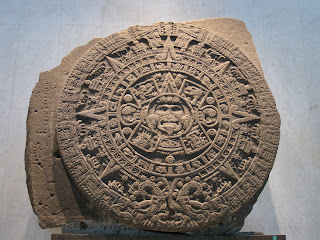Calendric Wisdom South Of The Border
The calendric wisdom of indigenous Mesoamericans has come to be increasingly appreciated in recent years. As prescient observers of celestial cycles and their connections, agricultural and otherwise, to terrestrial events, they came to remarkably similar conclusions about the nature of time itself, despite striking cultural disparities. Spurred by academic impetus imparted by early investigators along with the pending conclusion of the thirteenth Baktun, scholarly interest has focused primarily upon Mayan temporal mensuration. Other systems evolved throughout this region, however, also offer fascinating material, especially when evident parallels are highlighted and psychically explored. Lucky Six Farms, in particular, is convinced that the depths of Mesoamerican calendric wisdom have yet to be fully or fairly plumbed.
Calendric Wisdom - Aztec And Maya
Probably the best known alternate Central American calendric system was developed by the Aztecs. The complex nature of all such systems has long been recognized, since each significant social group employed not just one but several intercalated calendars, each with a specific purpose. Like the Maya, the Aztecs recognized an overriding ceremonial primacy for a recurring 260-day cycle wherein constituent units were assigned simultaneous numerical and symbolic aspects. Enumeration was progressively incremented through subcycles of thirteen digits but twenty symbols, thus requiring passage of 260 days until numeral and symbol again matched their initial configuration, resetting the cycle at its starting point. The Maya referred this the entire sacred 260-day count as the Tzolkin, while the Aztecs used the term Tonalpohualli. In both cases, however, it is clear that the orderly designations were utilized to accommodate a highly specific sequence of presiding deities. The better these entities and the transitions from one to another were understood, the better one could adapt to shifting conditions inherent in their qualities.
Calendric Wisdom - Interpreting The Counts
It is interesting to note how even extreme pressures of cultural heterogeneity coupled with inevitable vicissitudes and horrors engendered by foreign conquest have produced so few ostensible divergencies in attributes of individual days. For example, the day on which I am penning this blog according to the Tzolkin is 12 Muluc (Water); its Tonalpohualli designation is 12 Atl (Water). Thus, despite semantic differences, key aspects of the period remain virtually identical. Although this kind of striking consistency is by no means uniform across the two calendric systems, it is nonetheless common enough to be indicative of a powerful noumenal foundation, a conceptual base transcending arbitrary vagaries of cultural whim and accident. In this spirit, we hope our inventory of venerable herbal aromatics, including smudge sticks and White Sage essential oil, smudge cones, and whole leaves, always subserves their highest traditional and sacred roles.
By Alan Beck



No comments:
Post a Comment
We all benefit when you share your opinions -- Please Comment, even just to say "I like this!"